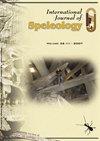通过风洞和珠宝洞的气压传播建模:如何通过表面压力测量预测气压洞穴内的气压信号?
IF 1.3
4区 地球科学
Q3 GEOSCIENCES, MULTIDISCIPLINARY
引用次数: 0
摘要
最近的洞穴气候学研究通过确定压力改变过程和导致洞穴和地表气压之间的系统差异,揭示了气压洞内气压动力学的新进展。在此基础上,建立并探索了一个多步骤的定量模型,用于预测美国南达科他州布莱克山两个主要的气压洞穴系统——风洞和宝石洞的气压。因此,每一个确定的大气气压过程都被转化为一个数学运算。基于Pearson相关性和模型输出与控制测量之间的平均(绝对)偏差的模型评估得出了很好的结果:根据不同的位置,所提出的模型预测了风洞内99.2%至99.7%的测量气压,而宝石洞内的预测结果为90.3%和99.4%,从而证明了先前确定和现在建模的过程充分和全面地描述了气压洞内的洞穴气候压力动态。由于电梯运行造成的不规则压力扰动和珠宝洞深层独特的形态特征,风洞内电梯下层和珠宝洞内深营的模型表现稍弱。在所有研究地点对模型常数和模型精度的空间比较分析显示,洞穴之间的压力模式存在显著差异,从而证明了形态特征对气压传播和由此产生的变化的影响。这些发现也支持了早期对风洞和宝石洞的研究,因为它们为之前观察到的两个洞穴之间气流动力学的差异提供了洞穴气候学背景。因此,该研究对了解气压洞穴的复杂洞穴气候学有重要贡献。本文章由计算机程序翻译,如有差异,请以英文原文为准。
Modeling air pressure propagation through Wind Cave and Jewel Cave: How can air pressure signals inside barometric caves be predicted from surface pressure measurements?
Recent speleoclimatological research has shed new light on air pressure dynamics inside barometric caves by identifying pressure-modifying processes and resulting systematic differences between cave and surface air pressure. Based on these new findings, a multi- step quantitative model is developed and explored to predict air pressure inside Wind Cave and Jewel Cave – two major barometric cave systems in the Black Hills of South Dakota, USA – from external surface measurements. Therefore, each identified speleoclimatological pressure process is translated into a mathematical operation. Model evaluation based on Pearson correlation and mean (absolute) deviation between model outputs and control measurements yields good to excellent results: Depending on the location, the presented model predicts 99.2% to 99.7% of measured air pressure inside Wind Cave compared to 90.3% and 99.4% inside Jewel Cave, thus proving that the previously identified and now modeled processes adequately and comprehensively describe the speleoclimatological pressure dynamics inside barometric caves. Slightly weaker model performance is observed at the lower elevator level inside Wind Cave and at Deep Camp inside Jewel Cave due to irregular pressure disturbances caused by elevator operation and unique morphological features in the deeper parts of Jewel Cave, respectively. Comparative spatial analyses of model constants and model accuracies at all investigated locations reveal significant differences in pressure patterns between the caves, thus demonstrating the effect of morphological characteristics on air pressure propagation and resulting modifications. The findings also support earlier research in Wind Cave and Jewel Cave as they provide speleoclimatological background for previously observed differences in airflow dynamics between both caves. Therefore, this study presents an important contribution to understanding the complex speleoclimatology of barometric caves.
求助全文
通过发布文献求助,成功后即可免费获取论文全文。
去求助
来源期刊

International Journal of Speleology
地学-地球科学综合
CiteScore
3.10
自引率
23.10%
发文量
12
审稿时长
>12 weeks
期刊介绍:
The International Journal of Speleology has the aim to get cave and karst science known to an increasing number of scientists and scholars. The journal therefore offers the opportunity to all scientists working in and on karst to publish their original research articles or their review papers in an open access, high quality peer reviewed scientific journal at no cost. The journal offers the authors online first, open access, a free PDF of their article, and a wide range of abstracting and indexing services.
 求助内容:
求助内容: 应助结果提醒方式:
应助结果提醒方式:


